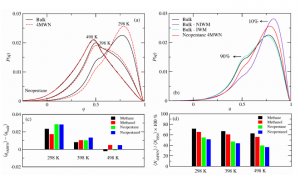
Kazimieras Tamoliūnas and Nuno Galamba
The hydrophobic effect plays a key role in many chemical and biological processes, including protein folding. Nonetheless, a comprehensive picture of the effect of temperature on hydrophobic hydration and protein denaturation remains elusive. Here, we study the effect of temperature on the hydration of model hydrophobic and amphiphilic solutes through molecular dynamics aiming at getting insight on the singular behavior of water concerning the zero entropy temperature Ts and entropic convergence also observed upon protein denaturation. We show that, similar to hydrocarbons and proteins, polar amphiphilic solutes exhibit a Ts, although strongly dependent upon solute-water interactions, opposite to hydrocarbons. Further, the temperature dependence of the hydration entropy normalized by the solvent accessible surface area is shown to be nearly solute size independent for hydrophobic but not for amphiphilic solutes, for similar reasons. These results are further discussed in the light of information theory (IT) and the structure of water around hydrophobic groups The latter shows that the tetrahedral enhancement of some water molecules around hydrophobic groups, associated with the reduction of water defects, leads to the strengthening of the weakest hydrogen bonds, relative to bulk water. However, a larger tetrahedrality is found in low density water populations, demonstrating that pure water has encoded structural information similar to that associated with hydrophobic hydration, consistent with IT assumptions. The source of the differences between Kauzmann’s “hydrocarbon model” on protein denaturation and hydrophobic hydration is also discussed with relatively large amphiphilic hydrocarbons displaying a more similar behavior to globular proteins, than aliphatic hydrocarbons.
Doi: 10.26434/chemrxiv.12084918.v2
Cited as: Tamoliūnas K, Galamba N (2020). Protein Denaturation Zero Entropy Temperature, and the Structure of Water Around Hydrophobic and Amphiphilic Solutes. ChemRxiv. Preprint. https://doi.org/10.26434/chemrxiv.12084918.v2.



